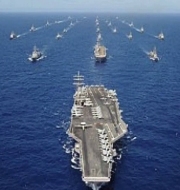RIMPAC 2016: World’s largest international maritime exercise kicks off
World’s largest international maritime exercise named RIMPAC (Rim of the Pacific) 2016 began in Pacific Ocean at Hawaii, United States.
RIMPAC 2016 will see participation of navies from 26 countries. This year it is the 25th edition of biennial exercise in the series that began in 1971.
RIMPAC 2016 Theme: “Capable, Adaptive, Partners”.
Key Facts
- In this edition of exercise (from 30 June to 4 August 2016), 45 ships, 5 submarines, about 200 aircrafts and 25000 personnel are participating.
- 26 Participating Countries are: Australia, Brunei, Canada, Chile, Colombia, Denmark, France, Germany, India, Indonesia, Italy, Japan, Malaysia, Mexico, Netherlands, New Zealand, Norway, China, Peru, Korea, Philippines, Singapore, Thailand, Tonga, the United Kingdom and the United States.
- Participating countries will exercise wide range of capabilities including complex warfighting, maritime security, disaster relief operations and sea control.
- It will also include war games that will cover the Hawaiian Island and southern California.
- In RIMPAC 2016, three new nations are participating for the first time. They are Denmark, Germany and Italy.
- India is being represented by Indian Naval ship (INS) Satpura, an indigenously built guided missile stealth frigate.
About Rim of the Pacific (RIMPAC) Exercise
- The RIMPAC is the world’s largest international maritime warfare exercise. It is held biennially during June and July of even-numbered years from Honolulu, Hawaii.
- It is hosted and administered by the United States Navy’s Pacific Fleet (headquartered at Pearl Harbor) in conjunction with the Marine Corps, the Coast Guard, and Hawaii National Guard forces under the control of the Governor of Hawaii.
- Host country United States invites military forces of countries from the Pacific Rim and beyond to participate.
- The biennial exercise seeks to provide a unique training opportunity to participants in order foster cooperative relationships to ensure the safety of sea lanes and security on the world’s oceans.
Month: Current Affairs - July, 2016


